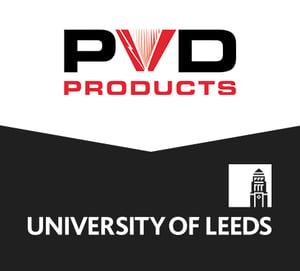 To showcase the work our customers do and their experience with our thin film deposition systems, we’re continuing our series of blogs that highlight our customers and their unique thin film applications. We continue the series with Dr. Gin Jose.
To showcase the work our customers do and their experience with our thin film deposition systems, we’re continuing our series of blogs that highlight our customers and their unique thin film applications. We continue the series with Dr. Gin Jose.
Dr. Jose, Chair in Functional Materials at the University of Leeds, owns two systems from PVD and utilizes both for his research needs. We caught up with him to learn more about his experience working with our team and his current work in thin film applications.
What is your professional background?
I've been involved in academic photonics research for 20 years. I earned my Ph.D. in laser spectroscopy in India in 2003, did post-doctoral research in Italy for a year and a half, and then took a faculty position with the Indian Institute of Technology Guwahati.
I began my professorship at the University of Leeds in 2007 when I accepted a faculty position. I’ve had a lot of research opportunities come my way since joining Leeds and currently I serve as Chair in Functional Materials here at the University.
Broadly speaking, what is your area of research?
I primarily study photonics applications, including amplifiers, lasers, and biosensors. We use femtosecond lasers to modify the surfaces of glass and semiconductor materials. The specific use is embedding ions within substrates. We focus on three primary applications:
- Strengthening materials
- Creating photonic circuits
- Developing non-invasive glucose sensors
Our current priority is expanding the scale of production. We’re looking to develop new prototypes for commercialization. Starting next year, we should be prototyping glucose sensors.
What thin film deposition systems did you purchase from PVD?
We purchased two instruments – a PLD system with both excimer (nanosecond) and femtosecond lasers and later a large area PLD system with a femtosecond laser. The first system, purchased in 2007, is used to apply glass films to substrates and to develop the ion-embedding process.
Our second system, the femtosecond laser, is used to implant ions into the glass. When we bought the second system, we incorporated more custom design to have larger deposition regions and more uniform coatings.
Why did you choose to buy a product from PVD Products?
There were four reasons we chose to partner with PVD.
- PVD is experienced in the field. We needed a vendor who understood our research so that we could discuss our specific needs in detail. It made it easier to talk through the technical specifications of our system. Our team also had prior knowledge and familiarity with PVD's deposition systems, which contributed to the decision.
- They have a high level of custom-design flexibility. These capabilities were key to getting the system we needed. We required some custom components for heating and inter-operation with a separate laser. PVD built the necessary diagnostics into the system, such as an optical spectrometer.
- PVD collaborated closely with our team. Their researchers worked in conjunction with ours to ensure the system met capability and performance specs. We performed pilot studies together, and now PVD is a research partner. They even joined the University of Leeds SeaMatics (Seamless Integration of Materials for Photonics) program.
- PVD’s scalability was unmatched. We could not find any other companies that could scale production as needed. This was a big motivating factor for partnering with PVD.
Can you tell us more about how you worked with PVD to develop your deposition system?
The entire process was collaborative. Our Leeds team provided an outline of our requirements which included parameters for uniformity and thickness, as well as requirements for large radii and some specific diagnostics. We also provided PVD with information about the lasers we currently used.
During each part of the design process we had Skype calls with PVD. This helped us optimize cost while also allowing us to be very involved in the design. We made three on-site visits – a preview of the product, a final inspection, and training to use the lasers and custom components. PVD also assisted as we prepared facilities for the new equipment, ensuring everything was in order before installation. This included measuring the stairs and lifts and designing the lab layout so that everything fit. They understand the importance of facility planning prior to system install.
What did you enjoy about designing and purchasing your deposition system from PVD?
PVD didn’t treat our project like just another system. They understand our processes, which makes it easy to discuss technical issues at a high level. During the design and assembly process of our systems, PVD was in continuous communication with us. Following the sale, we have appreciated their continued technical support. We can contact them any time to get issues resolved and we trust we’ll receive the highest quality of service from them. Our original system is 11 years old and still operating. The relationship has been reciprocal—our feedback has helped PVD make improvements in their own designs.
Planning for a new deposition system? Start with our free guide:
Choosing a Thin Film Deposition System
If you’d like to learn more about our collaborative process and how we can work with your team to design a system that meets your needs, contact our team.
About Dr. Gin Jose
Dr. Gin Jose is the Chair in Functional Materials at University of Leeds. He is currently leading the £2.5 million EPSRC manufacturing project SeaMatics (www.seamatics.org) aimed at developing next generation photonic integrated circuits for optical and data communication in collaboration with researchers at universities of Sheffield, Cambridge and York. He is also co-founder/Director of Glucosense Diagnostics Ltd (www.glucosence.net) and Ultramatis Ltd (www.ultramatis.com).



Leave a Comment